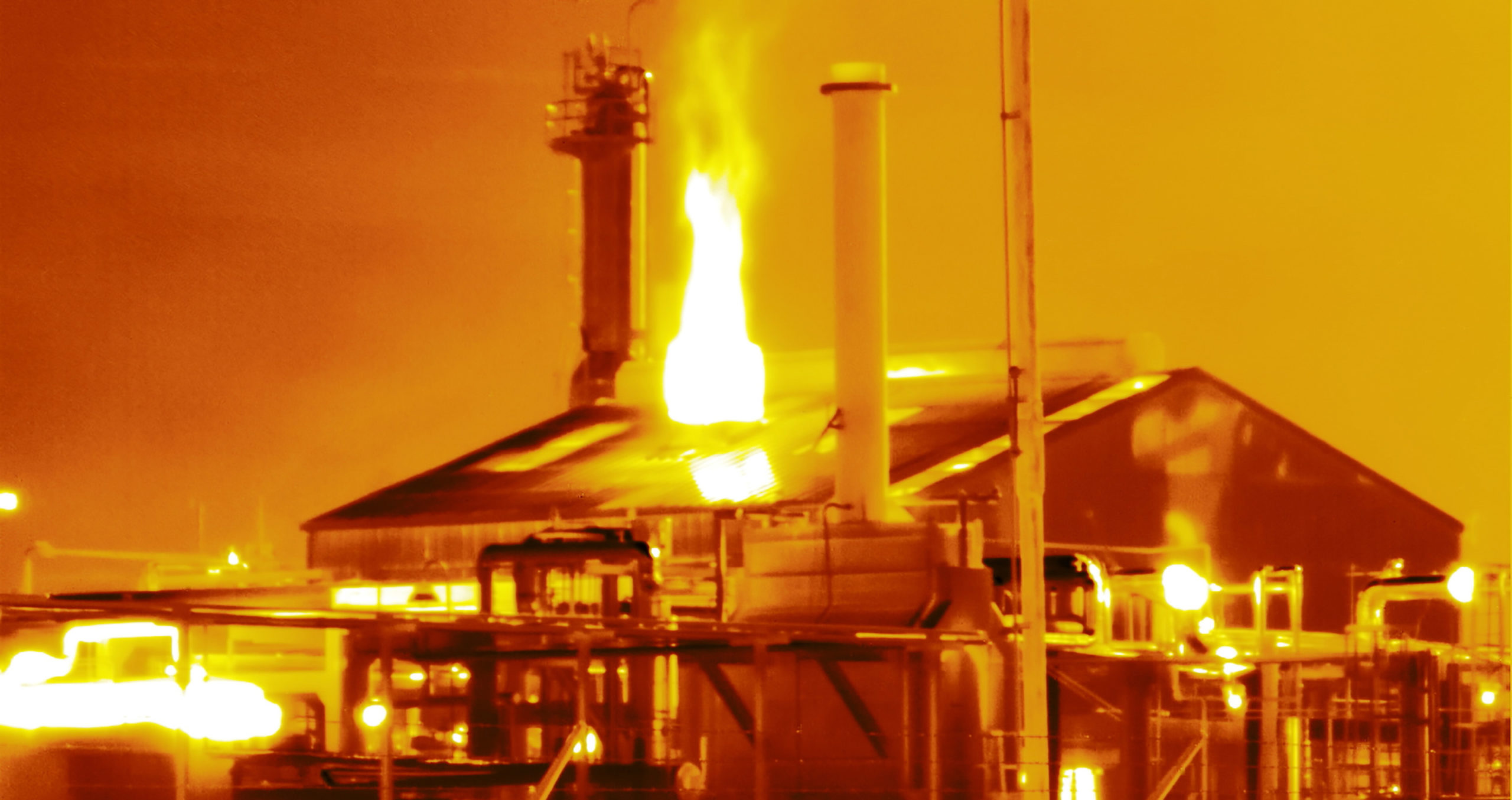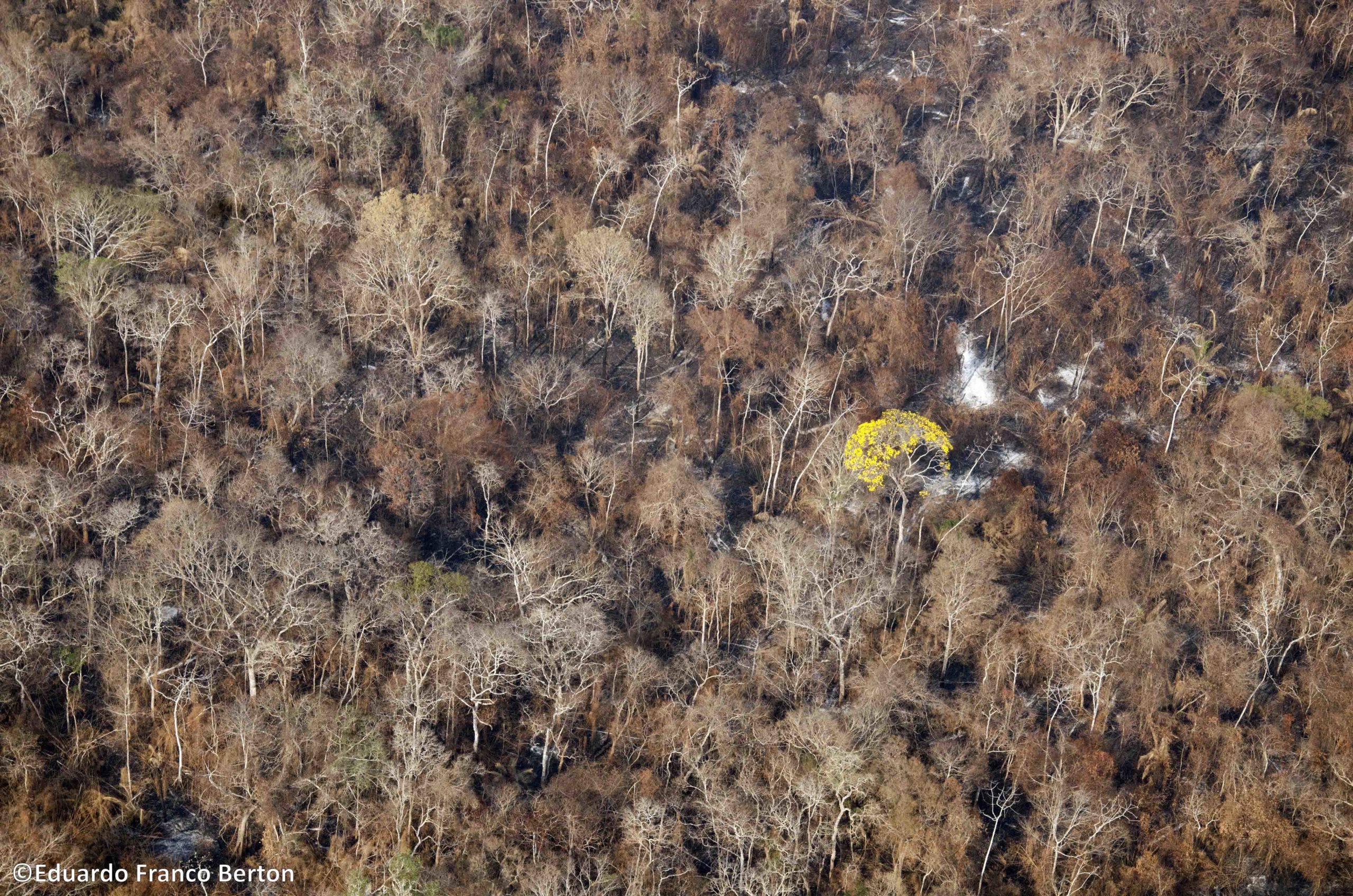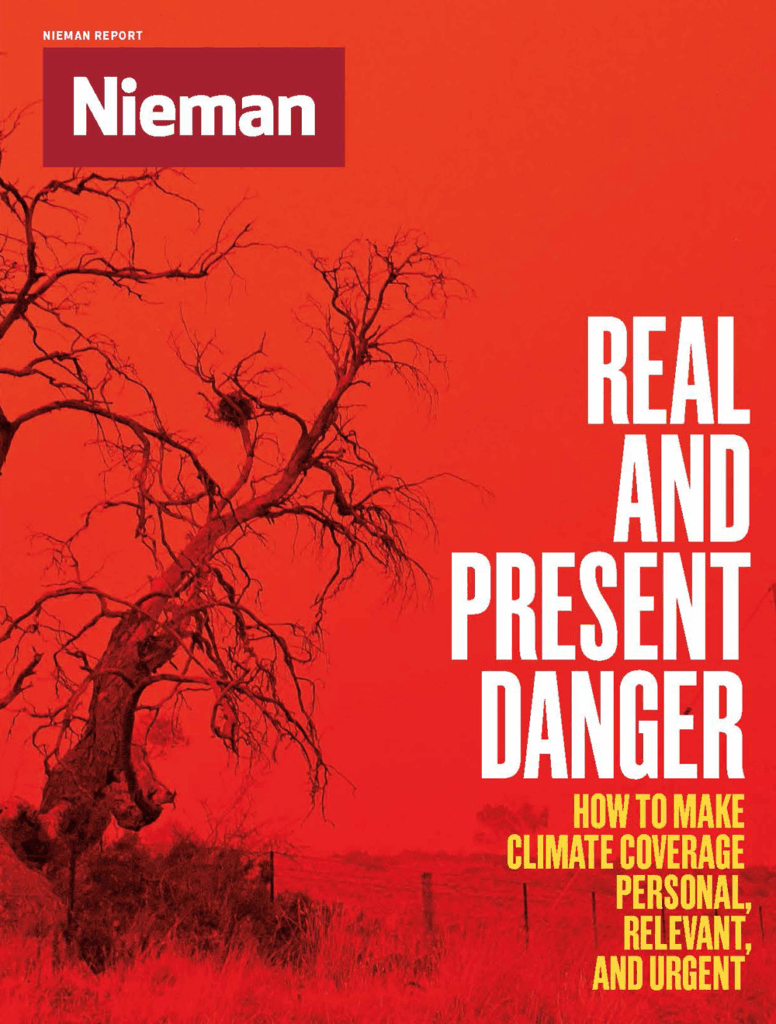Bushfires in Australia. Disintegrating ice in Greenland and Antarctica. Devastating hurricanes in the Caribbean. Record-breaking temperatures around the world—again. Hardly a day goes by when climate change and its consequences aren’t at the top of the news.
And yet, climate change remains one of the most challenging stories for media to cover well. The sheer magnitude of the problem, and its unrelenting slow burn of destruction, makes it difficult to engage readers in a personal way. Stories either stultify in a barrage of statistics, or overwhelm with gloom and doom that leaves readers paralyzed.
Related Reading
Gina McCarthy’s Advice to Climate Journalists: “Talk about Solutions and Build Hope”
By Gina McCarthy
Five Tips for Better Coverage of the Climate Crisis
By James Painter and Shannon Osaka
Reporting the Climate Crisis through (Really) Slow Journalism
By John D. Sutter
As the following stories show, however, journalists—from the United Kingdom to Bangladesh, from Morocco to Texas—continue to find new creativity to make climate change accessible, urgent, and engrossing. Since climate change is a global problem, we searched around the world—from the United Kingdom to Bangladesh, from Morocco to Texas—to find some of the most distinctive and engaging climate change journalism in recent years. Not surprisingly in our digital age, much of it is visual, multimedia, interactive, employing a multiplicity of tools to immerse readers in the enormity of the issue while at the same time personalizing it to each reader, viewer, or user.
Journalists continue to find new creativity to make climate change accessible, urgent, and engrossing
In Bolivia, a photographer shoots one tree that brings alive the enormity of South American wildfires. In Morocco and Malaysia, a new media studio uses virtual reality to transport audiences into the lives of vulnerable people on the bleeding edge of climate disaster. In Texas, two New York Times journalists find new ways to make visible the unseen causes of climate change. In Bangladesh, a local reporter showcases the resilience of local women in a daily struggle against sea-level rise. In London, a multimedia team personalizes climate change impacts down to the choices we make for breakfast. And in Washington, DC, a newsletter producer goes social in her fight against fossil fuel advertising.
Each of these journalists in their own way has fought to communicate one of the most important messages a journalist can convey: pay attention.
Virtual reality
A man lifts a bucket from a well, hand over hand, his face wrapped in cloth. “The well is empty,” he finally sighs. “There is nothing. The things that belong to this land are gone.”
The word “oasis” may conjure images of verdant palms in the midst of the desert, but for the 2 million people who live in oases in Morocco, increasing desertification is drying up trees and causing crops to fail, threatening their very existence. Lithuanian filmmaker Viktorija Mickute immerses viewers in their plight in her film, “The Disappearing Oasis.” “I wanted to show people who feel very detached from climate change how this is actually affecting people now,” says Mickute. “The desert is powerful in a way that is difficult for humans to fight.”
Rather than playing out the issues onscreen, however, Mickute brings viewers directly into the disappearing oasis using virtual reality. She and three colleagues with AJ Contrast, a division of Al Jazeera, filmed inhabitants using 360-degree cameras, making the consequences of climate change vivid and intimate for viewers. “People say climate change is a faraway issue that does not affect them,” Mickute says. “This medium helps bring the story to these people and say this is actually happening, you cannot wish it away.”

Even with the enhanced capabilities of the technology, Mickute makes sure in her films to focus on storytelling, finding a guide who can take viewers through the location. For “Oasis,” that guide is Halim Sbai, a local cultural organizer who shows off his village and points out places where water and trees once flourished, in areas that are now just dirt and sand. She recut the film several times to work in the science in ways that would be meaningful but subtle, not overshadowing the lived experience of the people on the ground. She was also careful not to just highlight the bleakness of the situation, but focus on ways that inhabitants had learned to cope. In Sbai’s case, he had created a traditional music school and festival, which includes workshops and tree-planting to help reforest the land.
“Oasis” isn’t the only story Mickute’s studio has filmed on climate-related issues; another VR film, “The Curse of Palm Oil,” examines the mass deforestation of palm-oil plantations in Malaysia, which both exacerbates climate change and poisons local water sources. Both films have been recut to appear on all of Al Jazeera’s channels, including television and social media apps; as well as being available in VR for Oculus and at film festivals. Mickute has been especially gratified at film festivals when many of the questions are about what viewers can do to help. “I would hope that it makes people think about how they impact other people’s lives,” Mickute says, “that they are more connected to these people and these locations than they think.”
Email newsletter
As Emily Atkin scrolled through her Twitter feed last year, she kept seeing advertisements from ExxonMobil and other fossil fuel companies. Instead of advertising their oil and gas production, however, they were touting their supposed green bona fides with products such as algae biofuels. “I see more ads about Exxon’s algae biofuels than I actually see algae biofuels in the world,” Atkin says. “These companies are taking one thing they do that’s environmentally friendly, and mining the crap out of it.”
As the author of HEATED, a four-times-a-week newsletter she founded last September to shine a spotlight on climate issues, Atkin considered the ads to be manipulative at best. After all, Twitter had just banned political advertisements from its site. Weren’t these ads designed to sway politics around energy and climate policy? “The ads they put out are in the service of making them more money by burning more fossil fuels,” says Atkin. “They do that in part by manipulating people into thinking that’s not what they are doing.” She began investigating the issue, talking to experts who found fossil fuel ads were often misleading, and increased in frequency during climate debates or lawsuits, as a clear attempt to influence public opinion.

The coverage is emblematic of the kind of reporting Atkin features in her newsletter, which she calls “accountability journalism.” “I try and keep in mind my job is to speak truth to power, and focus on climate change as a story about power and money rather than a story about science and the environment,” she says. “[MSNBC journalist] Chris Hayes famously said climate change is a ratings killer, but what grabs people more than money and power?” That’s a different approach from the more traditional reporting she did on climate for the likes of Think Progress and The New Republic, which focused on science and strived to maintain a neutral tone. “If you are reporting on something that is objectively alarming, shouldn’t you sound alarmed?” she asks.
Her approach has clearly struck a chord, as Atkin has about 2,000 subscribers paying $75 a year and 20,000 readers who have a free subscription. It’s also been effective. A week after her fossil fuel ad story, presidential candidate Elizabeth Warren tweeted it out, tagging Twitter CEO Jack Dorsey, and a week later, Twitter changed its policy. Now climate activists as well as fossil fuel companies can buy political ads on Twitter. Atkin has since started an Instagram page, @fossilfuelads, which crowdsources examples of misleading fossil fuel ads from readers. “I thought it would be impactful to see them all in the same place to better visualize the landscape,” she says.
Beyond Twitter, she hopes to open a conversation among media companies such as The New York Times and National Public Radio about allowing fossil fuel ads, which she thinks undercut fact-based reporting. In January The Guardian became the first major global news organization to stop accepting advertising from oil and gas companies. “Is it ethical to run something in the pages of the most highly respected newspaper in the country that actively misleads people?” Atkin asks. “I think The New York Times should have an honest discussion about it and grapple with the facts and implications of what they are doing.”
Infrared photography
One of the biggest energy stories of the past decade has been the rise of natural gas. “It’s been positioned as something that can help us in our fight against climate change, because it is much cleaner than coal,” says New York Times climate reporter Hiroko Tabuchi. “Switching to natural gas was supposed to bring down emissions.” In the course of her reporting, however, Tabuchi came across reports about leaks in gas plants of methane, a greenhouse gas with more than 25 times the global warming potential of carbon dioxide.
In the Times’s photos, innocuous pictures of oil and gas infrastructure transform into roiling cauldrons dramatically leaking bright yellow gas
What’s more, the Trump administration has been considering new rules cutting back the regulation of methane emissions, which could exacerbate the problem. As Tabuchi considered how to best report the story, she ran into a problem, however: methane is invisible to the naked eye, making it difficult for readers to visualize. “I could have done a conventional story and gotten the numbers, but you can see readers’ eyes glaze over,” she says. “It wouldn’t have made any impact.”
Instead, she partnered with Times cinematography director Jonah M. Kessel, who proposed a unique way of picturing the issue: using infrared photography so readers could see the massive gas leaks with their own eyes. The result was an interactive online story, in which innocuous pictures of oil and gas infrastructure transform into roiling cauldrons dramatically leaking bright yellow methane gas from pipes, tanks, and even whole buildings.
The images weren’t easy to obtain; in order to find leaks, Tabuchi and Kessel chartered an expensive atmospheric research plane to fly over Texas oil fields in search of high methane readings. Once they pinned down coordinates, they drove through a maze of oil refineries in search of spots from which they could photograph. The camera equipment itself was bulky, requiring a special lens that had to be cooled down to -200 degrees C in order to capture the images. That in turn, required a massive camera battery that took 10 minutes to cool the camera to the right temperature, as Tabuchi and Kessel contended with heavy truck traffic barreling down highways and plant workers and security suspicious of their project.
Instead of shaky “night vision”-type infrared images, they were able to create stunning high-resolution images that readers themselves are able to manipulate to see more than what can be seen with the naked eye. “We’re constantly evolving in how we use video,” Kessel says. “Five years ago, we would have made a linear video, now we are always asking, ‘What is the best way to tell the story?’”
The story was so visually striking, it caught the attention of U.S. senators, who used it in exhibits on the floor of the Senate during debate about methane regulations. Whatever lawmakers decide, at least they will be able to see what they are discussing. “Right now there is an attack on science and an attack on truth in some ways,” says Kessel. “Having the information be so clear makes it harder to refute.”

Aerial photography
As fires raged through South American forests last summer, an image went viral on the internet: an aerial view of a devastated landscape, with hundreds of burned, leafless trees. Among them, a single tree bloomed with bright yellow flowers. The photographer, Eduardo Franco Berton, spied the lone Tajibo tree flowering in the midst of the Chiquitano dry forest as he flew in an airplane 300 meters above the forest canopy; he only had time to take three quick shots as the plane wheeled away to give way to a supertanker dropping water on the blazing forest below.
When he saw the photo back on the ground, however, Berton knew it was the perfect image to illustrate the massive extent of the destruction. “It was very impactful to see how precious that tree was kept because the whole area had been devastated,” Berton says.
An independent journalist with the Bolivia-based Red Ambiental de Informacion (Environmental Information Network), Berton started taking wildlife photos 11 years ago; at the same time, he began writing articles focusing on environmental issues affecting his native Bolivia and surrounding countries. Chief among them is deforestation, which has destroyed about 865,000 acres a year since 2011 in Bolivia for agribusiness.
“When you dive into the scientific papers, you find that the deforestation is changing the local climate, increasing the dry season in the Chiquitano,” Berton says. At the same time, the local rise in temperature has increased the propensity for fires, which in turn causes a vicious circle of more deforestation. Despite the evidence, however, Berton says local politicians generally support more deforestation, and are apt to turn the blame for climate change elsewhere. “You always listen to politicians saying climate change is an issue caused by first-world countries and corporations, but never take responsibility for what we are doing in our own country,” he says.
When the fires began raging this summer — eventually burning nine million acres in Bolivia — Berton realized that he had a chance to report on the magnitude of the problem; however, the biggest fires were occurring far from roads, making taking photos unfeasible, even using drones. He worked with a nature photographer who had outfitted a plane with a special window for taking photos directly down onto the canopy, and was willing to offer time at half-price.
Affected by the devastation, Berton initially shared the photo of the lone tree on his Facebook page with a depressing message. “I wrote something like, ‘When a tree dies, you probably don’t care, but when millions of trees die, I’m sure you will suffer’ or something like that,” he says. As thousands of people began sharing and commenting on the photo—some making it their background picture on social media—they were more apt to see the single tree as a symbol of hope or resistance. He sold the image to news organizations, but also allowed environmental organizations to use it free of charge. “I think it caused a big impression among people,” he says, “because nature will always find a way to recover.”
Daily newspaper
As a child growing up on the coast of southwestern Bangladesh, Banani Mallick remembers going to the market with her father, and seeing saplings of papayas, coconuts, and other fruits and vegetables for sale for local farmers to grow. Now a reporter with Dhaka-based The Daily Observer, Mallick gradually saw those saplings disappear, as salinity from rising sea levels due to climate change turned the land barren, forcing locals to buy those crops elsewhere. “It has become a big challenge especially to the people who live in the coastal area,” Mallick says. “I witness their every struggle against such an unfavorable situation.”
Mallick’s story provided a first-hand look at how those most affected by climate change are learning how to fight back against it
Even as those farmers have struggled, however, Mallick observed local women adapting to the difficulties, drawing upon knowledge passed down for generations to start growing those crops again. Mallick wrote about this phenomenon in an article for the Observer, providing a first-hand look at how those most affected by climate change are learning how to fight back against it. Some women, for example, have built up tall circular beds using cement rings, filling them with salt-free soil along with ashes, cow dung, and leaves, that allows them to both grow crops for themselves and improve their livelihood by selling them to others.
For Mallick, the story not only shed light on the real-time effects of climate change on a vulnerable population, but it also highlighted the often-ignored role of women in Bangladeshi society. “The women farmers’ contribution from my community was completely unpublished,” she says. “Such success has made these women farmers financially solvent and empowered.”
Mallick received aid in telling the story from Earth Journalism Network, a Washington, D.C.–based nonprofit that has worked with journalists in developing countries for more than 15 years to help them report on environmental issues. In addition to a grant allowing her to pay for travel, documents, and other expenses, Mallick received mentoring by managing editor Sara Schonhardt, who helped her structure and report the piece for maximum impact. “Our idea is to create a sustainable model by helping to bolster the information and resources journalists get,” Schonhardt says, allowing them to produce “high-quality coverage looking at local communities and voices that are traditionally underrepresented in kinds of stories.”
Articles EJN funds often address efforts by locals to adapt to climate challenges, striking a balance between presenting the severe damage climate change causes, and the ingenious ways communities have adapted to its effects. “We don’t want stories to be fluff pieces or gloss over the problem, but we also don’t want them to be sob stories,” she says. “The way communities are showing agency and taking the initiative often gets overlooked.”
Mallick echoes that notion in her story, showing in a close and intimate way how marginalized communities are wrestling with a global phenomenon. “We, the coastal people, witness the worst impact of climate change, and see its bad impact on health, economy, and biodiversity,” says Mallick. “But amidst this crisis, I profoundly feel that it is important to raise a hope in the mind of the people, that despite all these odds, we humans have an incredible ability to cope.”
Personal calculator
Eating oranges a couple of times a week for a year produces as much greenhouses gas as driving a car 6 miles. Eating avocados the same amount, however, creates more than six times as much —equivalent to driving 39 miles. Neither food choice is remotely comparable, however, to eating beef with the same frequency, which produces annual emissions equivalent to driving 1,542 miles, or taking a flight from London to southern Spain.
“Food production is a big source of greenhouse gas emissions, but there is a lot of confusion about the impact of different food choices,” says Helen Briggs, a science journalist and broadcaster with BBC News. The network helps bridge that gap with an interactive food calculator, which allows users to plug in the frequency with which they eat different food items and determine how much they are contributing to an individual’s annual greenhouse gas emissions. “This tool is designed to take published scientific data,” says Briggs, “and present it in a way that is accessible, meaningful, and useful.”
BBC’s calculator succeeds in showing rather than telling readers just how much they can personally make a dent in climate change emissions
The idea for the piece came from a University of Oxford study published in Science, which showed that food production was a significant if overlooked contributor to climate change—accounting for a quarter of all greenhouse gas emissions. Not all food, however, contributes equally. Particularly egregious are meat and dairy products, consumed in abundance by Western societies, which are having an outsized influence on climate emissions. Briggs co-wrote the story along with data journalists Nassos Stylianou and Clara Guibourg. Rather than just reporting on the study’s findings, they wanted to make the story more urgent for readers, by showing how diet influences their own personal environmental footprint.
“The aim was to reach a wide audience using a simple, engaging tool, which can be used time and time again in stories,” Briggs says. In order to do that, they roped in a team of journalists, designers, and developers to create an interface that is fun and attractive—complete with bright cartoon images of different foodstuffs—but nevertheless packs a calorie-dense meal of sobering information. In a broadcast feature on the tool, most users expressed surprise and incredulity at different impacts of different food choices. “People were amazed that the type of food you eat can make such a difference to your carbon footprint,” Briggs says.
In addition to showing the amount of carbon created in producing a food, the calculator provides graphs and facts in a Q&A format to help readers make sense of how their diet compares to other choices they might make. The story succeeds in showing rather than telling readers just how much they can personally make a dent in climate change emissions just by changing to a more plant-based diet. “We hope it’s a good way to get scientific data out there, which will inform people about the environmental implications of the choices they make over what to eat and drink,” Briggs says.
An earlier version of this story misstated the number of subscribers to Emily Atkin's newsletter and inaccurately described Twitter's new policy regarding ads.




